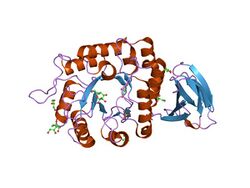Biology:Glycoside hydrolase family 27
| Melibiase | |||||||||
|---|---|---|---|---|---|---|---|---|---|
 crystal structure of rice alpha-galactosidase | |||||||||
| Identifiers | |||||||||
| Symbol | Melibiase | ||||||||
| Pfam | PF02065 | ||||||||
| Pfam clan | CL0058 | ||||||||
| InterPro | IPR000111 | ||||||||
| SCOP2 | 1ktc / SCOPe / SUPFAM | ||||||||
| CAZy | GH27 | ||||||||
| |||||||||
In molecular biology, glycoside hydrolase family 27 is a family of glycoside hydrolases.
Glycoside hydrolases EC 3.2.1. are a widespread group of enzymes that hydrolyse the glycosidic bond between two or more carbohydrates, or between a carbohydrate and a non-carbohydrate moiety. A classification system for glycoside hydrolases, based on sequence similarity, has led to the definition of >100 different families.[1][2][3] This classification is available on the CAZy web site,[4][5] and also discussed at CAZypedia, an online encyclopedia of carbohydrate active enzymes.[6][7]
Glycoside hydrolase family 27 together with family 31 and the family 36 alpha-galactosidases form the glycosyl hydrolase clan GH-D, a superfamily of alpha-galactosidases, alpha-N-acetylgalactosaminidases, and isomaltodextranases which are likely to share a common catalytic mechanism and structural topology.
Alpha-galactosidase (EC 3.2.1.22) (melibiase)[8] catalyzes the hydrolysis of melibiose into galactose and glucose. In man, the deficiency of this enzyme is the cause of Fabry's disease (X-linked sphingolipidosis). Alpha-galactosidase is present in a variety of organisms. There is a considerable degree of similarity in the sequence of alpha-galactosidase from various eukaryotic species. Escherichia coli alpha-galactosidase (gene melA), which requires NAD and magnesium as cofactors, is not structurally related to the eukaryotic enzymes; by contrast, an Escherichia coli plasmid encoded alpha-galactosidase (gene rafA P16551)[9] contains a region of about 50 amino acids which is similar to a domain of the eukaryotic alpha-galactosidases. Alpha-N-acetylgalactosaminidase (EC 3.2.1.49)[10] catalyzes the hydrolysis of terminal non-reducing N-acetyl-D-galactosamine residues in N-acetyl-alpha-D- galactosaminides. In man, the deficiency of this enzyme is the cause of Schindler and Kanzaki diseases. The sequence of this enzyme is highly related to that of the eukaryotic alpha-galactosidases.
External links
References
- ↑ "Conserved catalytic machinery and the prediction of a common fold for several families of glycosyl hydrolases". Proc. Natl. Acad. Sci. U.S.A. 92 (15): 7090–7094. 1995. doi:10.1073/pnas.92.15.7090. PMID 7624375. Bibcode: 1995PNAS...92.7090H.
- ↑ "Structures and mechanisms of glycosyl hydrolases". Structure 3 (9): 853–859. 1995. doi:10.1016/S0969-2126(01)00220-9. PMID 8535779.
- ↑ "Bairoch, A. "Classification of glycosyl hydrolase families and index of glycosyl hydrolase entries in SWISS-PROT". 1999.". http://www.expasy.ch/cgi-bin/lists?glycosid.txt.
- ↑ "Home" (in en). http://www.cazy.org/.
- ↑ Lombard, Vincent; Golaconda Ramulu, Hemalatha; Drula, Elodie; Coutinho, Pedro M.; Henrissat, Bernard (2014-01-01). "The carbohydrate-active enzymes database (CAZy) in 2013" (in en). Nucleic Acids Research 42 (D1): D490–D495. doi:10.1093/nar/gkt1178. ISSN 0305-1048. PMID 24270786.
- ↑ "Glycoside Hydrolase Family 27" (in en). http://www.cazypedia.org/index.php/Glycoside_Hydrolase_Family_27.
- ↑ CAZypedia Consortium (2018-12-01). "Ten years of CAZypedia: a living encyclopedia of carbohydrate-active enzymes". Glycobiology 28 (1): 3–8. doi:10.1093/glycob/cwx089. ISSN 1460-2423. PMID 29040563. https://hal.archives-ouvertes.fr/hal-01886461/file/Hehemann_2018_01.pdf.
- ↑ "Biochemistry of α‐Galactosidases". Advances in Enzymology and Related Areas of Molecular Biology. Advances in Enzymology - and Related Areas of Molecular Biology. 36. 1972. 91–120. doi:10.1002/9780470122815.ch3. ISBN 9780470122815.
- ↑ "Nucleotide sequences and operon structure of plasmid-borne genes mediating uptake and utilization of raffinose in Escherichia coli". J. Bacteriol. 171 (12): 6753–6763. 1989. doi:10.1128/jb.171.12.6753-6763.1989. PMID 2556373.
- ↑ "Human alpha-N-acetylgalactosaminidase-molecular cloning, nucleotide sequence, and expression of a full-length cDNA. Homology with human alpha-galactosidase A suggests evolution from a common ancestral gene". J. Biol. Chem. 265 (35): 21859–21866. 1990. doi:10.1016/S0021-9258(18)45818-8. PMID 2174888.
 |

